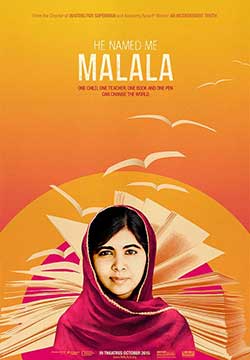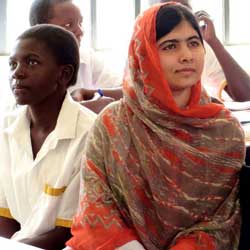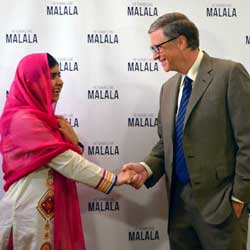
See featurettes about the movie at Fox Searchlight.
“I chose this life”
I’ve written in the past about films that seem ideal — and important — for parents (and grandparents) to watch and discuss with their children. I have a current recommendation, a film that for me addresses the theme of individual courage at a time when newspapers are filled with accounts of tens of thousands of families seeking refuge from war and its turmoil.
The film is He Named Me Malala, an inspiring new documentary by Oscar-winning Davis Guggenheim (An Inconvenient Truth).
He Named Me Malala is another portrait of Malala Yousafzai, the young Pakistani teenager who was shot by the Taliban for daring to speak out about the importance of educating Muslim girls. By now this remarkable young woman is pretty much a household name. Her book, I Am Malala, has been on best-seller lists for months, and in her journey to spread her inspirational message about gender equality she’s addressed the United Nations, visited with President Obama in the White House, met Queen Elizabeth at Buckingham Palace, and sat down for a chat with Hillary Rodham Clinton.
On top of all that public attention Malala, in 2014 at age 17, was awarded the Nobel Peace Prize, the youngest ever Nobel Peace Laureate. That’s how we’ve come to know Malala Yousafzai.
Wise beyond her years

With director Davis Guggenheim. (Image courtesy of Fox Searchlight.)
But there’s much more to the story. Guggenheim’s film, as the title implies, is just as much about the “he” who named her Malala: her politically-charged father, Ziauddin Yousafzai, who seems to emerge as a primary source of his daughter’s own unswerving commitment to justice. When Malala is shown addressing the United Nations General Assembly, her father sits just behind, as if looking over his daughter’s shoulder.
The backstory to the symbiotic political relationship between father and daughter is one embedded in historical folklore, and it is treated in the film much in the manner of a child’s picture book. He Named Me Malala begins with a water-color-brushed animation sequence, which depicts the 1880 Maiwand battle between Afghan and colonial British forces. As the soldiers on horseback charge one another, a young woman drifts among the animated images.
From this stylized beginning we learn that Ziauddin Yousafzai named his daughter Malala after Malalai, a folk-hero Pashtun woman who is said to have inspired the victorious Afghan fighters during the Maiwand battle. She died for the cause. It is she who is envisioned wandering fearlessly in the midst of the battle. The symbolic nature of Malala’s folklore name resonates in the course of the film with multiple possibilities as the relationship of father and daughter unfolds.
Questions arise: Did Ziadunnin Yousafzai prophetically envision a daughter that, like her namesake, would become a courageous woman of destiny? To what extent did his own role as an education activist shape his daughter’s? Near film’s end Malala addresses these questions herself, saying that her father gave her only her name. “He didn’t make me Malala. I chose this life,” she states. And you believe her because at this point Malala has been revealed as a young woman who is poised, confident, and wise beyond her years.
A family affair
Guggenheim documents Malala’s story with commendable craftsmanship and narrative structuring. Rather than follow a chronological sequence of events, the initial narrative of He Named Me Malala centers on the displaced Yousafzai family — mother, father, Malala, and her two younger brothers who are living in Birmingham, England. They moved there for Malala’s intensive medical recovery.

(Image courtesy of Fox Searchlight.)
So, as much as it’s Malala’s story, the documentary is also a lovely, intimate portrait of the Yousafzai family as a unit. As they sit around a simple kitchen table, the siblings are depicted as lively, normal youngsters — caught in typical conversations about the challenges of adapting to British schooling and new social relationships, about the possibilities of boyfriends and girlfriends. They engage in lively brother-sister assessments of each other. In one scene Malala and her older brother have a go at arm wrestling. At one poignant moment Malala speaks of the past — a time before the assassination attempt and the facial surgery that took away half of her beautiful smile.
And, of course, home life is not ideal. The siblings must help their mother, an uneducated woman, as she struggles to accept and blend into a new and different culture. Clearly she longs to be back home in Pakistan with her Swat Valley friends. She is seen wandering about a large Birmingham produce market, unable to bring herself to buy anything.
The development of the Yousafzais as a typical family provided a strong humanistic lead-in for the newsreel replay of Malala’s sensational backstory: the assassination attempt in 2012, and the fight for her life in Pakistan before being flown to the U.K. for surgical procedures that, miraculously, would restore Malala’s body and mind. Cameras caught the life-death drama in the operating room. At this point the backstory also intercuts footage of Malala’s early advocacy speeches that led to the Taliban death threats and eventually the assassination attempt on a bus. This footage is important because it reminds us that Malala’s inspirational campaigns back then were just as forceful as those she would make after being shot.
Courage under fire

Meeting Bill Gates. (Image courtesy of Fox Searchlight.)
For the 2012 bus shooting scene Guggenheim again employs storybook animation to powerful effect — terrorism rendered in hand-drawn abstract images of Taliban shots firing and striking a helpless school girl.
Later the cameras were at the hospital in England to capture Malala’s first conscious moments after the Taliban bullets struck her head. This “awakening” sequence is the most powerful and moving in the film — revealing the moment when the Malala we’ve been watching in the documentary as a recovered 18-year-old woman defied death and went on to resume her brave mission.
Although Malala has traveled widely around the world to speak and to open schools, her dream, spoken time and again in the latter part of the film, is to be able to return home to Pakistan. But the Taliban death threat still hangs over her and her father. Even so,the film shows that Malala’s spirit and commitment remain undiminished.
There is much to ponder and discuss about Malala’s inspiring story: her determination to make a difference in an imperfect world; the source of her strength and dedication; the importance of family in times of crisis and unexpected dislocation. Malala’s story is personal and time- and place-specific, but its message is a universal call to courage and action.
National Geographic has announced it will air He Named Me Malala in 171 countries in 45 languages. Classroom and discussion guides to supplement the film are available at the National Geographic Education website.



